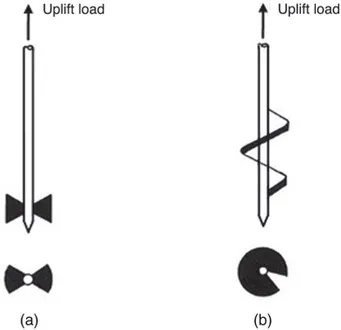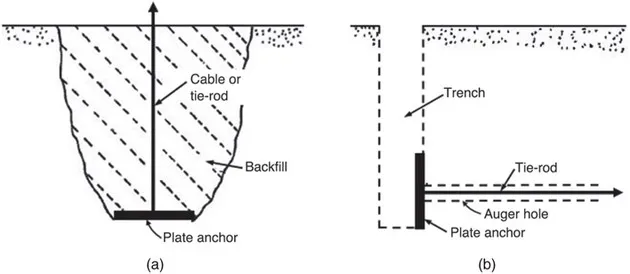
- 352 pages
- English
- ePUB (mobile friendly)
- Available on iOS & Android
eBook - ePub
Earth Anchors
About this book
Anchors are primarily used in the construction of foundations of earth-supported and earth-retaining structures. The fundamental reason for using earth anchors in construction is to transmit the outwardly directed load to the soil at a greater depth and/or farther away from the structure. Although earth anchors have been used in practice for several hundred years, proper theoretical developments for purposes of modern engineering designs have taken place only during the past 40 to 45 years. This geotechnical engineering book summarizes most theoretical and experimental works directed toward the development of proper relationships for ultimate and allowable holding capacity of earth anchors.
Frequently asked questions
Yes, you can cancel anytime from the Subscription tab in your account settings on the Perlego website. Your subscription will stay active until the end of your current billing period. Learn how to cancel your subscription.
At the moment all of our mobile-responsive ePub books are available to download via the app. Most of our PDFs are also available to download and we're working on making the final remaining ones downloadable now. Learn more here.
Perlego offers two plans: Essential and Complete
- Essential is ideal for learners and professionals who enjoy exploring a wide range of subjects. Access the Essential Library with 800,000+ trusted titles and best-sellers across business, personal growth, and the humanities. Includes unlimited reading time and Standard Read Aloud voice.
- Complete: Perfect for advanced learners and researchers needing full, unrestricted access. Unlock 1.4M+ books across hundreds of subjects, including academic and specialized titles. The Complete Plan also includes advanced features like Premium Read Aloud and Research Assistant.
We are an online textbook subscription service, where you can get access to an entire online library for less than the price of a single book per month. With over 1 million books across 1000+ topics, we’ve got you covered! Learn more here.
Look out for the read-aloud symbol on your next book to see if you can listen to it. The read-aloud tool reads text aloud for you, highlighting the text as it is being read. You can pause it, speed it up and slow it down. Learn more here.
Yes! You can use the Perlego app on both iOS or Android devices to read anytime, anywhere — even offline. Perfect for commutes or when you’re on the go.
Please note we cannot support devices running on iOS 13 and Android 7 or earlier. Learn more about using the app.
Please note we cannot support devices running on iOS 13 and Android 7 or earlier. Learn more about using the app.
Yes, you can access Earth Anchors by Braja Das,Sanjay K. Shukla in PDF and/or ePUB format, as well as other popular books in Technology & Engineering & Civil Engineering. We have over one million books available in our catalogue for you to explore.
Information

EARTH ANCHORS:
GENERAL
GENERAL

Earth anchors are constructed to resist the loads which cause instability to structures such as foundations, earth retaining structures, and slopes. During the last three to four decades, the experimental and mathematical research works relating to earth anchors have accelerated, and the results of those works have been published in various technical journals and conference proceedings. This chapter introduces the very basic description of earth anchors and most of their types commonly used in geotechnical engineering structures. A comprehensive review of the specific anchor types and their engineering aspects is presented systematically in the following chapters.
1.1 INTRODUCTION
Anchors used in soil and rock, commonly called earth anchors, are primarily designed and constructed to resist outwardly directed loads imposed on structures such as foundations, earth retaining structures, and slopes. These outwardly directed loads are transmitted to the soil and rock at a greater depth by the anchors.
Buried anchors have been used for thousands of years to stabilize structures. Tents are the oldest structures which were stabilized by using anchors or stakes. Until the middle of the 19th century, anchors were primarily used for stabilizing fairly lightweight structures. With the design and construction of large suspension bridges, very large loads were transmitted to the bridge foundations. In order to support these loads, permanent anchoring systems in rock medium were gradually developed and constructed.
With the development and construction of special lightweight structures such as lattice transmission towers and radar towers, design of special tension anchoring systems for foundations became necessary, primarily because the wind load created reactions that were greater than the self-weight of the structures.
Earth anchors of various types are now used for uplift resistance of transmission towers, utility poles, aircraft moorings, submerged pipelines, and tunnels. Anchors are also used for tieback resistance of earth retaining structures, waterfront structures, at bends in pressure pipelines, and when it is necessary to control thermal stress.
The earlier forms of anchors used in soil for resisting vertically directed uplifting loads were screw anchors. Figure 1.1 shows two different configurations of screw anchors. These anchors were simply twisted into the ground up to a pre-estimated depth and then tied to the foundation. They were used either singly or in groups.
In general, at the present time, earth anchors can be divided into seven basic categories: plate anchors, direct embedment anchors, helical anchors, grouted anchors, anchor piles and drilled shafts, suction caisson and drag anchors, and geo-anchors. Some authors refer to plate anchors as direct embedment anchors.

FIGURE 1.1 Two different configurations of screw anchors
1.2 PLATE ANCHORS
Plate anchors may be made of steel plates, precast concrete slabs, poured concrete slabs, timber sheets, and so forth. They may be horizontal to resist vertically directed uplifting load, inclined to resist axial pullout load, or vertical to resist horizontally directed pullout load, as shown in Figures 1.2a to 1.2c. These anchors can be installed by excavating the ground to the required depth and then backfilling and compacting with good quality soil. They may be referred to as backfilled plate anchors (Figure 1.3a). In many cases, plate anchors may be installed in excavated trenches, as shown in Figure 1.3b. These anchors are then attached to tie-rods, which may either be driven or placed through augered holes. Anchors placed in this way are referred to as direct bearing plate anchors. In the construction of sheet pile walls, primarily used for waterfront structures, vertical backfilled or direct bearing plate anchors are common. Figure 1.4a shows the cross section of a sheet pile wall with a vertical anchor. The vertical anchors of height h and width B and spaced with a center-to-center spacing of S are tied to the sheet pile wall, as shown in Figure 1.4b.

FIGURE 1.2 Plate anchors: (a) horizontal plate anchor, (b) inclined plate anchor, and (c) vertical plate anchor

FIGURE 1.3 Installation of plate anchors: (a) backfilled plate anchor and (b) direct bearing plate anchor

FIGURE 1.4 Use of vertical plate anchor in sheet pile wall: (a) section and (b) plan
In many cases, horizontal anchor beams along with batter piles can also be used in the construction of sheet pile walls (Figure 1.5).
1.3 DIRECT EMBEDMENT ANCHORS
Direct embedment anchors are similar in nature to direct bearing plate anchors (Figure 1.6). They may be triangular or take any other penetrative shape, and they are installed vertically by driving with a rod to a desired depth. After the desired depth is reached, the rod is withdrawn and the cable is tensioned to rotate the anchor through an angle of 90° into its final position.
1.4 HELICAL ANCHORS
Helical anchors consist of a steel shaft with one or more helices attached to it (Figure 1.7). An anchor made by suitably connecting a prefabricated steel screw helix element to a steel shaft is called a single-helix...
Table of contents
- COVER
- TITLE
- COPYRIGHT
- TABLE OF CONTENTS
- PREFACE
- THE AUTHORS
- CHAPTER 1. EARTH ANCHORS: GENERAL
- CHAPTER 2. HORIZONTAL PLATE ANCHORS IN SAND
- CHAPTER 3. HORIZONTAL PLATE ANCHORS IN CLAY
- CHAPTER 4. VERTICAL PLATE ANCHORS
- CHAPTER 5. INCLINED PLATE ANCHORS
- CHAPTER 6. HELICAL ANCHORS IN SAND
- CHAPTER 7. HELICAL ANCHORS IN CLAY
- CHAPTER 8. ANCHOR PILES
- CHAPTER 9. SUCTION CAISSON AND DRAG ANCHORS
- CHAPTER 10. GEO-ANCHORS